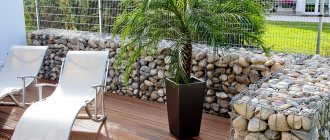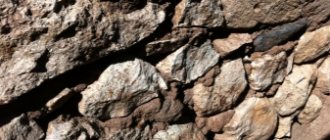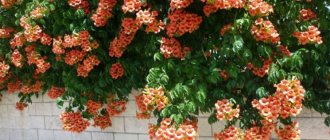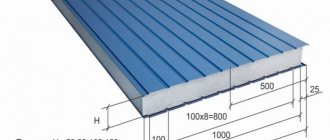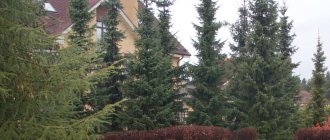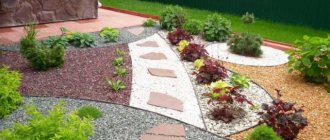Gardeners and professional landscape designers love evergreen thujas, because they will delight you 12 months a year with their greenery and lush crown. Thujas have an amazing ability to purify the air, filling the garden with a subtle resinous aroma. Arborvitae can be safely called coniferous plants, which occupy a leading position in the garden. The variety of crown shapes, heights, and colors of needles provide a wide range of applications in landscape design. Tall varieties form dense and dense hedges, spherical and topiary forms act as tapeworms on an emerald lawn, and dwarf varieties are comfortably located in rock gardens and rock gardens. Thuja occidentalis is the most common species; it has many varieties, from which you can create almost any design solution.
Advantages and disadvantages
Thuja is an unpretentious crop, well adapted to Russian climatic conditions. It tolerates frost well and can grow both in a shaded area and in the sun. The plant harmonizes perfectly with its relatives in landscape compositions: juniper, spruce, cypress.
The greenery of the thuja, used for garden design, is dense, but soft, and lends itself well to molding. Most varieties grow slowly, but there are also hybrids with accelerated growth. From them you can create real architectural parks. A new direction has emerged in landscape design – topiary art. Gardeners form cars, animals, geometric shapes and objects from shrubs.
Thuja needles have another advantage: they release phytoncides and disinfect the air. It is useful to grow it near the home for people suffering from respiratory diseases.
Preparing for winter
Thujas tolerate winter quite well, but some preventative measures should still be taken. The main problem with trees is damage to branches due to snow weight. To avoid such a situation, it is better to tie the thuja branches before the onset of frost. Young seedlings are covered with spruce branches or craft paper. This will protect the plant both from damage by snow cover and from the burns of the first spring sun.
At the Green Paradise nursery you can always buy thuja seedlings for planting with delivery throughout Moscow and the Moscow region. Pickup is also available. Free replacement of dead plants under a warranty service agreement.
Go to catalog →
Plant shapes
You can create any shape from thuja. But each variety also has natural characteristics, which are classified into 5 types:
- pyramidal (plants reach 2-20 m depending on the variety);
- columnar (grows up to 5 m, used to create hedges);
- umbrella-shaped (does not exceed 1 m in height, used to decorate flower beds);
- pin-shaped (2-meter thuja with dense branches that allow you to create hedges);
- spherical (a dense small shrub that changes during its life not only the size, but also the shade of the needles).
Experienced designers focus on the natural shape of the bush, using it from the most advantageous side.
Thuja in the country, in landscape design
Thuja is a magnificent tree suitable for decorating cottages, parks and estates.
This is an ornamental deciduous plant that belongs to the cypress order.
What are the benefits of thuja in the garden?
Thuja has many varieties, especially decorative ones. Many people call it a shrub, but it often has varieties up to 5 m high, like a full-fledged tree.
Young bushes have leaves that are pleasant to the touch, delicate, while adults have rough and scaly leaves.
Thuja is undemanding in care and is loved by summer residents and landscape designers. It is frost-resistant and, using many varieties, in combination with conifers at the dacha, you can create a magnificent winter garden.
Thuja fills the air with essential secretions, phytoncides that purify the air, disinfects it and fills it with secretions that cleanse the lungs and air of germs, fungi, and bacteria.
You need to handle thuja with care, because it contains a nootropic, thujone, which can be harmful, so for pulmonary diseases it is better to breathe in thuja vapors, which are brewed in small quantities. Don't drink thuja infusions.
Thuja occidentalis Waterfield
Types and varieties of thuja for landscape design
Thujas come in different types and varieties. The most common and popular types for the site:
Brabant - grows up to 5 m in height and up to 3 m in width. It grows up to 40 cm in a year. It loves moist, black soil, but does not tolerate winter and spring temperature changes. It survives well at temperatures down to -35-37 C. In landscape design it gives the best results when planted as a hedge.
Thuja occidentalis Golden Brabant
Thuja occidentalis Brabant
Pyramedalis is a compact tree, with a pyramidal crown, with vertical trunks, of which there may be several, growing together.
Branches with elastic leaves twisted in different directions. The needles are beautiful, dark green, sometimes with a blue tint. Winter-hardy, but suffers from burns in the spring, so this is one of the varieties that is always covered.
Plant only in well-drained holes with good water drainage. Does not like wet soils. It tolerates frosts down to -40 C. It is good both in a hedge and as a solo plant.
Thuja occidentalis Pyramidalis compacta
Thuja occidentalis Douglas and Pyramidalis
Spiralis - distinguished by twisted needles. It has dark green needles with a slightly bronze tint. One of the varieties that requires constant pruning. The good thing about this variety is that it becomes more beautiful over time. Its crown expands and becomes fluffier.
Tree height up to 15 m, width up to 6 m. In a year it will grow up to 30 cm. Loves moist soils and sunny places. This type is most often used in the treatment of pulmonary diseases.
Thuja occidentalis Spiralis
Golden Globe is a small, compact variety, distinguished by the fact that the tips of the needles of the bush are golden in color, and from the inside, closer to the trunk, the crown of the bush is dark green.
The difference in color adorns each bush and the entire landscape design as a whole. Grows up to 1.2 m per year, growing upward by 7-10 cm. Grows on moderately moist soils, loves light shade.
Thuja occidentalis Golden Globe
Thuja occidentalis Gold Pearl
Reingold - a variety that grows slowly, a variety with a spherical crown, no need to cut it, it grows in the form of a ball. It grows up to 1.5 m in height. It grows up to 6 cm per year, the soil should be loose and moist. Withstands up to -39 C. No need to cover. Ideal for rockeries and alpine slides.
Thuja occidentalis Rheingold
Thuja occidentalis Recurva Nana
The Sagrada grows in the form of a pyramid, with several trunks and several tops. The color is dark olive. The needles are dense, sharp, height - 1.5, width - 2.8 m. It will grow only 8 cm per year. The soil should be moist, with drainage, the place is moderately shady. Used to decorate terraces.
Thuja occidentalis Smaragd Norditerran
Thuja occidentalis Globosa Compacta
Danika is the perfect ball that is only possible in a thuja. The width of the ball-shaped bush reaches 1 m. A fluffy bush grows because the branches grow and puff up in different directions. Likes soils that are drained and moderately moist.
Thuja occidentalis Danica Aurea
What place and soil to choose for thuja
You need to choose a place protected from the wind. Cold winds will change the direction of growth of thuja branches and therefore you will not get a beautiful landscape plant. A draft will make the tree sick, as it will lose its immunity.
Also, this plant does not like the hot sun, because its needles are soft and from the heat they will change color to copper and will dry out.
Choose a place with deep groundwater. If the roots grow deep in wet soil, they will rot. The best soils are acidic, loose, chernozem and fertile, where air and water freely penetrate.
When is the best time to plant thuja?
Thuja is planted in the spring. It does not belong to plants that easily take root in cold periods.
She needs to strengthen herself after landing. Therefore, it is better in the spring. The earth should be very warm from +20 C. In the south they plant at the end of March, in the middle zone - at the end of April, in the northern regions - in mid-May.
Thuja eastern Sieboldii (Sieboldii)
Thuja Sichuan
How to choose a thuja seedling
Seedlings come with closed and open root systems. When choosing, inspect the seedling carefully. Do not take if there is even the slightest damage, broken, there should be no traces of pests, the plants should be 3 or 4 years old, they easily take root in the most difficult places.
Choose one with a flexible, fluffy, bright green, elastic crown. The roots should not be broken or dried out. If you take it with a closed one, then the roots should sit firmly in the pot and should not be easily removed from there. Pull, if you don’t immediately pull out, it means the roots are strong.
Thuja occidentalis Elegantissima
Thuja cuprea (Cuprea)
How to plant a thuja seedling
To plant a thuja seedling, you must first dig a hole twice as large as the roots. The hole is dug with a depth of 0.9 m and a width of 1.8 m. Mix peat and dug soil, sand in the proportion: 1: 2: 1. You can also fill the hole with substrate from the store.
The bottom of the hole is filled with drainage purchased at the store or with pieces of broken brick and pebbles. Fill the hole halfway with soil mixture.
Without disturbing the coma at the roots of the thuja, place the seedling in the hole. If the roots are open, then straighten them carefully in different directions. In this case, the root collar should not be higher than 4 cm of the soil layer.
Compact the roots by adding a layer of soil and make a cushion of soil around the roots. Water the roots with water and cover the roots with soil. And water again, pouring up to 20 liters per seedling. Mulch the soil with wood chips, peat, and pine needles.
Thuja occidentalis Hoseri Sol
Thuja foldata Aurea
Thuja in landscape design
Thuja is a wonderful tree to decorate any area. Pyramid varieties can decorate the front entrance to the territory. Or decorate paths that spread throughout the area.
Also, pyramidal thujas look great around the perimeter of a dacha or as a hedge dividing spaces.
Alpine slides and rockeries with dwarf thujas or spherical specimens will be the delight of the owners. Thuja looks no less great in a coniferous mixborder and in a shrub mixborder.
Globular and topiary types of thuja are planted in flower beds to decorate them and to highlight the beauty of the flowers. Thujas are very popular as hedges, especially the Brabant variety. It trims well and can be planted in a beautiful checkerboard pattern, creating different shapes from it.
Also, spherical and dwarf thujas can decorate terraces if planted in tubs. Look great in mixed floral and oral compositions.
Thuja western Fastigiata
Thuja occidentalis Hoseri (Hoseri)
Combination with other plants
For a crop to look good in a composition, it must be correctly combined with other plants. When planning a site, take into account the characteristics of the soil and select decorative specimens that can grow on the same soil.
Thuja looks good next to spruces, cypresses, and mountain pines. Barberry, spirea, roses, magnolia, cinquefoil and low-growing apple trees will be excellent neighbors. Coniferous crops go well with heather and creeping juniper.
Self-formation of bonsai
Surprisingly, some gardeners give the bush-like thuja the shape of a bonsai tree. This is not easy to do. It is not enough to simply pinch and trim the plant.
To form a bonsai, it is necessary to give the shrub the appropriate shape, subjecting its branches to a forced change in the direction of growth, slightly breaking them in the process. The bent branch is fixed in a new direction and all branches are cut off.
Please take a look at the following article. It contains more useful information - Black currant: planting and care in open ground.
After some time, the bush will begin to form into a bonsai tree, where you should monitor the formation of the crown by constantly pruning.
Causes of yellowing of thujas. Thuja care
Place and features of planting and care
In order for the thuja to grow well, you need to choose a suitable place for it. It is advisable to plant plants in areas protected from winds and cold. In the north, the crop is placed in the sun. In the southern regions, needles often fade in the sun, so you should look for semi-shaded areas.
Shrubs do not like swampy areas with stagnant moisture, although they are not afraid of groundwater. On clay soils, it is worth putting drainage into the planting hole. The soil mixture for planting should include peat, sand, and some soil. The tree trunk circle on top is mulched with pine bark.
For rooting seedlings, choose spring or summer so that the crop can strengthen before the onset of cold weather. Watering should be moderate: do not overwater the plant. Winter-hardy varieties do not provide shelter when frost arrives. The exception is young seedlings, which are recommended to be covered with agrofibre. Eastern varieties of thuja are transferred indoors in containers for the winter.
Interesting! How to grow thuja from a branch
The main problem with the needles of the plant is fading in the sun. To prevent this from happening, the bush is covered with thin, breathable fabric, for example, gauze or agrofibre.
Features of reproduction
Gardeners often propagate thuja by cuttings, less often by grafting. The seed method is used to obtain planting material of species plants, since varietal and hybrid forms do not fully transmit external characteristics to seedlings.
Seed propagation
The oblong, flat seeds of the thuja ripen in the fall. For spring sowing, they are stratified for a month in damp sand on the bottom shelf of the refrigerator. Sometimes experts advise for better germination to carry out longer stratification - up to 3-5 months, and then additionally keep it warm for 2-3 months.
For sowing, prepare a substrate from turf soil, preferably collected from a coniferous forest, mixing it with peat in equal parts. Seeds are sown in furrows to a depth of 1–1.5 cm, watered and mulched with peat or humus chips.
The emerging seedlings are watered, shaded in the heat, and the area is kept clean, carefully pulling out weeds. Seedlings grow slowly, transplantation is carried out after one or two years, during this period two fertilizing sessions are carried out per season with fertilizers for coniferous plants. If there is a threat of fungal infections, crops are treated with Fundazol or Fitosporin-M.
Vegetative propagation
A simple, common method of propagating thuja is through cuttings using lignified or green cuttings. The seedlings obtained in this way fully correspond to the external characteristics of the mother plant.
Partially lignified cuttings with a heel, broken off at the base of the branch in June-July, take root best. Completely lignified cuttings are collected in May, but those obtained in the second half of summer will not have time to take root.
If it is not possible to break off cuttings with a heel, use pruning shears, taking pieces of shoots 2–3 cm long from dwarf varieties, and up to 20 cm from large ones. The cut is made obliquely and treated with Kornevin before planting. You should not take too many growths from the queen cells, as this will greatly weaken the plant.
For planting, use a greenhouse, placing in boxes a mixture of equal parts of sand, peat and turf soil. The cuttings are placed every 10–15 cm, watered with pink potassium permanganate and mulched with peat. The greenhouse is shaded in extreme heat, and regular watering and ventilation are carried out.
Usually, rooting lasts until autumn, and the next year the overwintered seedlings are placed in a permanent place, planted in containers or in a special area for growing.
Successful grafting requires certain skills, but allows you to grow strong seedlings of those varieties and hybrids that do not grow well on their own roots, or standard thujas.
For transferring a plant to “other roots”, two-year-old seedlings are excellent. To grow a standard form, you need to wait several years until the rootstock reaches the desired height, or purchase a ready-made specimen with an even trunk.
Cuttings are taken from 1-2 year old branches in early spring, when the plants are still dormant, stored in the refrigerator, wrapped in a damp cloth and immersed in a tightly closed container, for no more than 10 days. As soon as the buds of the rootstock begin to grow, make oblique cuts of the rootstock and scion, combine them into the butt and wrap them tightly with film. When young needles appear on the scion, the winding is loosened and then removed completely, applying a thin layer of garden varnish.
Design ideas
If the area is small, thuja can be used in single plantings. Several trees will look good on the area in front of the house, near a bench, in an area where there is a lot of sunlight.
Near the house you can combine thujas in containers with flowers in pots, combining different colors and shapes in a home composition. In a dacha or local area, it is not advisable to use tall, long-growing varieties.
Thujas look best as hedges or fences for alleys. It can be used to decorate balconies and terraces. For decorating small areas, medium-sized varieties reaching a height of up to 2 m are suitable. They lend themselves well to molding and look compact.
A beautiful design can be made from low-growing coniferous shrubs and paving slabs. It is alternated with plants in a checkerboard pattern. The composition can be fenced with taller varieties of shrubs.
In flower beds, plants in the shape of a ball or semicircle look best. Low-growing plants are also suitable for decorating a rock garden or a Japanese-style composition. Whatever options you choose, thuja will look advantageous everywhere, harmonizing with almost any type of garden crop.
How to care for thuja
Caring for the plant does not require any special labor costs or tricks; you just need to follow all the usual procedures for the normal development of the tree. In general, it comes down to watering, loosening, fertilizing and pruning rules.
In outskirts of Moscow
- Watering should be done on hot summer days at least once a week, preferably in the evening. The tree also responds well to sprinkling.
- Loosening is performed after watering to ensure air access. This is done shallowly - 5-7 cm, so as not to damage the root system. Periodically, the tree trunk of a young thuja needs to be weeded.
- Feeding is carried out in spring and summer. In spring, nitroammophoska is applied, in summer - potassium fertilizers. When fertilizing is applied during planting, the seedling is fertilized for the next year.
- Thuja pruning is carried out twice a year: in the spring - for sanitary purposes, then for shaping, in the autumn - only for adjusting the decorative form.
- Periodically, the tree needs to be checked for diseases or pests. Caring for thuja in the country includes protective and preventive treatments of the plant against pests.
In the Urals
In the Urals, only trees that tolerate frosty winters are planted. The classification according to winter hardiness zones includes 11 zones - it allows you to determine which plant is optimally suited to the climate zone. For the Urals, the winter hardiness zone is 3-4, which means that the 3rd zone should be marked on the seedling.
- In the Urals, spring and summer planting is recommended; work can be done until mid-September, using seedlings only with a closed root system.
- Water the tree from April to September every 3-4 days.
- In February, sanitary and formative pruning is carried out.
- Intensive feeding is carried out in March - nitroammophoska at the rate of 100g/5 l of water, in October - potassium nitrate and superphosphate.
- In November, the plant is prepared for winter.
Otherwise, you need to plant the plant and care for it in the same way as thujas in the Moscow region.
In Siberia
In the regions of Siberia, the climate is harsher than in the Urals - it corresponds to winter hardiness zone 4 with a minimum temperature of -40°C. When planting, add 3-4 kg of compost to each hole; next time the thuja can be fertilized in a year. Water thuja in hot weather at least every 1-2 days, per week - at least 100 liters of water. At the end of February, pruning is carried out.
Plant diseases and pests
In general, thujas get sick infrequently due to their good immunity. But they can be affected by the following diseases and parasites:
- Rust. Signs: red spots on the needles. Affected branches are disposed of by burning, and the plant is treated with Hom or Rakurs.
- Schutte. The needles become gray-brown. The affected shoots are removed, and the bush itself is treated with Topsin-M or Rakurs.
- Gray mold. The crown seems to be dusty, gray-brown in color. The disease is treated with Bordeaux mixture.
- Juniper scale insect. The most dangerous pest of thuja. It is difficult to fight; it often destroys the plant. The only effective option is treatment with Actellik in early June.
- Thuja false scale. Provokes the appearance of yellow ulcers. The preparations Aktara and Confidor are used for treatment.
- Thuja aphid. Gradually destroys needles. Confidor helps from her.
- Thuja leaf miner. It also destroys needles, although it does not cause too much damage. To get rid of it, it is recommended to use the drugs Calypso, Confidor, Enzhio.
Evergreen beauty thuja - brief information
The plant's Latin name Thuja is a type of evergreen tree and shrub from the cypress family (Cupressaceae). It includes 5 species, 3 species are grown in our conditions:
- western species (Thuja occdentalis);
- oriental species (Thuja orientalis);
- giant species (Thuja plicata).
The most popular Western varieties of thuja are:
- Brabant,
- Danika,
- Emerald,
- Teddy,
- Globoza,
- Reingold,
- Woodwardy,
- Golden Smaragd,
- Kuban emerald,
- Holmstrup.
Oriental thuja varieties:
- Aurea nana,
- Elegantissima,
- Westmont.
The natural habitat of thuja is North America, Asia. Numerous varieties are grown in gardens around the world. Typically, varieties suitable for creating fast-growing, well-formed hedges are used.
The branches of the thuja tree are fragile, usually dense to the base, sometimes old branches can become bare near the ground. The shoots are covered with tight-fitting, flat, scaly needles. When rubbed between your fingers, it releases a special pine scent.
The plants form oval cones consisting of several leathery scales. Seeds are elliptical, there are:
- flat, winged;
- thick, grainy, without wings.
How to distinguish a thuja from a cypress tree?
Due to its similar appearance, the plant is often confused with cypress trees. The plant differences are as follows:
| Plant characteristics | Thuja | Cypress |
| shoot tips | straight | hanging |
| scales | are never blue | come in blue |
| frost resistance | high | low |
Choosing the wrong choice of cypress instead of thuja usually leads to problems because cypress trees are less frost-resistant. Planting and caring for thuja is less demanding, and any carelessness in growing cypress can be fatal.
On the left is thuja, on the right is cypress
Ways to design a summer cottage
To make your suburban area look presentable and beautiful, you need to think in advance about how to arrange all the plants. To do this, it is worth studying the requirements for growing conditions and the characteristics of the varieties.
There are heat-loving species.
It is better for them to choose well-lit, sunny areas. It is preferable to plant individually in an open area.
Low-growing and medium-growing plants combine perfectly with each other. You can experiment with color and size, creating amazingly beautiful landscape views. It is not recommended to plant tall varieties in large quantities at a summer cottage, as they have a slow growth rate and require a lot of space. It is possible to plant several of these seedlings around the perimeter so that they do not block each other’s access to sunlight.
When planning a place for planting conifers, you need to prepare a planting hole, fertilize it with compost and water it as needed.
To form a high and powerful crown, the branches of a young thuja are not cut off. If you are pruning a plant, you need to know that in this case a bush is growing, but not a tree. At the same time, there are many types of ornamental bushes that need to be trimmed and you can experiment with the shape of the crown.
An ideal option for the decorative use of thuja is the formation of rockeries, as well as mixborders. In this case, luxurious alleys and original hedges are created.
Most Western cultivars make excellent additions to your yard throughout the year.
Tuami decorate both loggias and terraces. For such stylish growing, you do not need to purchase a large amount of soil. Low-growing thujas on the terrace are not afraid of frost.
Stamping
An artificially formed tree is called a trunk. The height of such a plant is 1–2 m. In relation to the tree-like thuja, this process will consist of the gradual removal of the lower branches. The result will be a part of a bare trunk, above which a lush crown will rise. Considering that it is impossible to cut off more than 30% of the branches at once, the gardener will need several years to form the desired shape of the thuja. Whether this should be done and whether such a thuja will be beautiful is up to you to decide.
The use of thuja in compositions depending on the type
The composition that is created can be:
- triangular;
- round;
- semicircular;
- oval;
- polygonal.
When planting a solo tree, place it in the center. A square flower bed can be created near the entrance to a private house - then the thuja is installed along its edges. The square can be divided into additional squares if you are creating a composition of miniature shapes. Thujas come in vertical, round and irregular shapes. The choice of variety will depend on whether you plan to plant a single plant or a group.
Wintering of thuja
Resistance to low temperatures largely depends on the type and variety of thuja. For example, Thuja plicata is completely frost-resistant. But Thuja occidentalis (Occidentalis Arborvitae) can easily freeze, especially if the tree is planted in open spaces in the garden. But the most sensitive to frost is Platycladus orientalis (oriental thuja). Young specimens of this species must be covered with agro-fabric in winter and polyethylene placed on top.
Absolutely all young seedlings also need protection from frost. To prevent thuja branches from breaking under the weight of snow in winter, wrap the entire tree with hemp rope.
Another possible feature of wintering: the needles of the thuja turn brown. But don't worry, this is a natural process that happens in winter. In spring, the needles turn bright green again.
Usage
The popularity of thuja is understandable: its variety and shape diversity allows it to be used in landscape compositions of any style. Having an attractive appearance, this breed is unpretentious, tolerates urban conditions well, is very frost-resistant, and lends itself well to haircuts. This set of positive qualities is enough to win everyone’s love and respect.
In 1566, his subjects from distant America brought the richest gifts to the French king: gold, clothing, Indian arts and crafts, the fruits of strange overseas plants and a slender coniferous tree with unusual scale-like leaves, spreading a pleasant aroma of resin. This exotic plant has taken root well in the climate of France. He tolerated the haircut perfectly, which made it possible to enrich the royal park with a variety of topiary figures. The French king appreciated the new plant and called it the tree of life , because its evergreen, fragrant needles enlivened the garden all year round.
This is how the thuja occidentalis acquired a second home in Europe. This magnificent slender tree, 12–20 m high, has a compact, low-hanging pyramidal crown.
| See also: |
Korean thuja (Thuja koraiensis)
This is an exquisite wide-shaped shrub or tree up to 9 m high. The needles look very impressive, they have silvery, very elegant needles. For the winter, such a crop necessarily takes refuge in our latitudes.
Often used in greenhouses. It is characterized by increased cold resistance, which determined its use in our region.
Thuja Standish or Japanese (Thuja standishii)
It grows up to 18 meters. It is distinguished by its cone-shaped shape and candelabra branches. Grows very slowly, long-lived.
The advantage of the culture is its incredible caramel-eucalyptus aroma with hints of lemon. In cold places it develops slowly, but in warm climates its development actively accelerates.
Where to plant ephedra on the site
Many owners of suburban areas are interested in the question: how to beautifully plant thuja on the site. This can be done in different ways. Place them in mixborders, plant them along the entire perimeter of the site, plant them in rock gardens and rock gardens. In other words, thuja looks beautiful in any garden design.
But the main thing is to choose the right place for active and proper growth of the tree. Depending on the variety, either a well-lit area or partial shade is selected. As for the soil, this plant is unpretentious to it, but most of all it loves loam. Therefore, when planting, it is recommended to mix fine river sand, peat and humus into the soil.
You cannot plant thuja in places where water often stagnates. This will lead to rotting of its root system and the death of the tree. The plant should also be protected from drafts and strong winds. The north-eastern side of the yard is selected for them.
Important : when planting thuja in a well-lit sunny meadow, it is worth considering that direct sunlight on the needles can cause burns on it.
